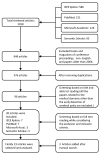AI Approaches Towards Prechtl's Assessment of General Movements: A Systematic Literature Review
- PMID: 32957598
- PMCID: PMC7570604
- DOI: 10.3390/s20185321
AI Approaches Towards Prechtl's Assessment of General Movements: A Systematic Literature Review
Abstract
General movements (GMs) are spontaneous movements of infants up to five months post-term involving the whole body varying in sequence, speed, and amplitude. The assessment of GMs has shown its importance for identifying infants at risk for neuromotor deficits, especially for the detection of cerebral palsy. As the assessment is based on videos of the infant that are rated by trained professionals, the method is time-consuming and expensive. Therefore, approaches based on Artificial Intelligence have gained significantly increased attention in the last years. In this article, we systematically analyze and discuss the main design features of all existing technological approaches seeking to transfer the Prechtl's assessment of general movements from an individual visual perception to computer-based analysis. After identifying their shared shortcomings, we explain the methodological reasons for their limited practical performance and classification rates. As a conclusion of our literature study, we conceptually propose a methodological solution to the defined problem based on the groundbreaking innovation in the area of Deep Learning.
Keywords: artificial neural network; cerebral palsy; fidgety movements; general movement assessment; machine learning; motion sensors; multimodal sensing; physical activity assessment; visual sensors.
Conflict of interest statement
The authors declare no conflict of interest.
Figures



Similar articles
-
Characteristics of general movements in preterm infants assessed by computer-based video analysis.Physiother Theory Pract. 2018 Apr;34(4):286-292. doi: 10.1080/09593985.2017.1391908. Epub 2017 Oct 24. Physiother Theory Pract. 2018. PMID: 29064734
-
Prognostic value of the qualitative assessments of general movements in late-preterm infants.Early Hum Dev. 2013 Dec;89(12):1063-6. doi: 10.1016/j.earlhumdev.2013.08.008. Epub 2013 Sep 1. Early Hum Dev. 2013. PMID: 24001477
-
Prechtl's assessment of general movements: a diagnostic tool for the functional assessment of the young nervous system.Ment Retard Dev Disabil Res Rev. 2005;11(1):61-7. doi: 10.1002/mrdd.20051. Ment Retard Dev Disabil Res Rev. 2005. PMID: 15856440 Review.
-
The importance of assessing general motor activity in premature infants for predicting neurological outcomes.Folia Neuropathol. 2022;60(4):427-435. doi: 10.5114/fn.2022.119593. Folia Neuropathol. 2022. PMID: 36734385
-
General movements: A window for early identification of children at high risk for developmental disorders.J Pediatr. 2004 Aug;145(2 Suppl):S12-8. doi: 10.1016/j.jpeds.2004.05.017. J Pediatr. 2004. PMID: 15292882 Review.
Cited by
-
A CMOS-integrated terahertz near-field sensor based on an ultra-strongly coupled meta-atom.Sci Rep. 2024 May 20;14(1):11483. doi: 10.1038/s41598-024-61971-x. Sci Rep. 2024. PMID: 38769178 Free PMC article.
-
Deep learning empowered sensor fusion boosts infant movement classification.Commun Med (Lond). 2025 Jan 14;5(1):16. doi: 10.1038/s43856-024-00701-w. Commun Med (Lond). 2025. PMID: 39809877 Free PMC article.
-
Video-Based Automatic Baby Motion Analysis for Early Neurological Disorder Diagnosis: State of the Art and Future Directions.Sensors (Basel). 2022 Jan 24;22(3):866. doi: 10.3390/s22030866. Sensors (Basel). 2022. PMID: 35161612 Free PMC article. Review.
-
Automating General Movements Assessment with quantitative deep learning to facilitate early screening of cerebral palsy.Nat Commun. 2023 Dec 14;14(1):8294. doi: 10.1038/s41467-023-44141-x. Nat Commun. 2023. PMID: 38097602 Free PMC article.
-
Towards novel classification of infants' movement patterns supported by computerized video analysis.J Neuroeng Rehabil. 2024 Jul 31;21(1):129. doi: 10.1186/s12984-024-01429-3. J Neuroeng Rehabil. 2024. PMID: 39085937 Free PMC article.
References
-
- Rosenbaum P., Paneth N., Leviton A., Goldstein M., Bax M., Damiano D., Dan B., Jacobsson B. A report: The definition and classification of cerebral palsy April 2006. Dev. Med. Child Neurol. Suppl. 2007;109:8–14. - PubMed
-
- Novak I., Morgan C., Adde L., Blackman J., Boyd R.N., Brunstrom-Hernandez J., Cioni G., Damiano D., Darrah J., Eliasson A.C., et al. Early, accurate diagnosis and early intervention in cerebral palsy: Advances in diagnosis and treatment. JAMA Pediatr. 2017;171:897–907. doi: 10.1001/jamapediatrics.2017.1689. - DOI - PMC - PubMed
Publication types
MeSH terms
LinkOut - more resources
Full Text Sources
Other Literature Sources
Medical
Research Materials

